
Miss Fanny and the Kappogi Aprons.
I have loved the Japanese apron for many years. My mom actually has had a pattern for it (and of course now we can’t find it.)
I love this apron because it covers everything. In honor of Thanksgiving and all the cooking we will be doing here next week (recipes to come of course), I thought I needed an apron that covered most of me so I can cook like a maniac, peel my apron off, and greet my guests in perfect cleanness.
A Sexy little apron is great when you are just heating things up for dinner or for doing the wash but when you are doing the "From Scratch Holiday Baking" that happens at Byrd house, you need a tent. Hee Hee
This apron was so easy to make. I had a ball. I hope the tutorial doesn't just mess everyone up.
The Kappogi is the tradidional Japanese "Country Style" apron. It was designed to keep your Kimono Clean. I was told that the word mean Kitchen and to wear so it is basically Kitchen ware. Funny.
My sister in law, Miyuki, let me borrow her apron to look at. I love hers but it was made for a small Japanese woman. I am not small or Japanese. My arms are just too long for it and I need it to go further around. Hee Hee. Sooooo….. I looked at hers and took many measurements and came up with something that will fit a taller, rounder, long armed Western Woman.
Here is the fairly simple tutorial (you’ve got to love Japanese simplicity.)
Here is the fairly simple tutorial (you’ve got to love Japanese simplicity.)
I started by taking my measurements and decided that the thing had to go around my widest part with some room to spare. I don’t think you need to know my numbers, (I don’t even want to know them.) I will give you my cutting measurements though.
Supplies:
2 yards fabric for the apron
1 fat quarter in a coordinating color for collar and pocket.
Some elastic for the sleeve.
Measurements:
I decided to make the apron 36” long. That puts it a mid thigh on me and I like that. You want it to be just longer than your finger tips so when you wipe your hands it goes on the apron and not your pants or dress. I decided to make the apron should be 50” round. That gives PLENTY of room. Hee Hee. If you need it narrower or wider you can adjust my measurements later. I also made the sleeves about 19” long.
This was so simple. Here is what I did. I took the fabric and made sure it was exactly 72” long (36”x2). From that I cut 1 piece of fabric 72” x 26”. This is for the front and back. I then cut that piece in half 2(36” x 26”). One of these is the front. I took the other and cut it in half 2(13”x36”) These make the back. You need to taper the shoulders. I did this by putting my ruler along the top edge of all the shoulders together and coming down 1” from the outer shoulder edge. I cut that off.
From the remaining fabric I cut the sleeves. My fabric was 46” wide so after the front and back were cut, that left me with a piece about 20” x 72” I evened things up and ended up with a piece that was 19 ½ inches wide. Each sleeve needs to be 19” x 30” . Take the sleeve pieces and fold them in half so they measure 15” x 19”.
Now take your ruler and measure up from the bottom edge to 8.5” down from the other edge. Cut along there. This will make the sleeve taper at the cuff.
Now the detail cuts for the neck hole.
The traditional neck hole on the Kappogi is square. That was a little complicated (for a tutorial) so I went for a rounded neck. It is easy to make, tute, and then I wasn’t copying the apron exactly. You can do what ever you like.
Take your apron front and fold it in half lengthwise. From the folded edge, come in 3”, from the top edge, come down 7 inches.
I used a pen and marked a curve that fit in those dimentions (the bowl helped with the curve.) Now cut out that piece and SAVE it.
Now to make the collar, I took the coordinating scrap I had and place the folded neck cut-out on top of it for a guild.
I cut that out and then added 2 ½” all the way around. I did this by laying the ruler next to the edge and making little marks and then connecting the dots and cut it out. Now you have a big U shaped piece.
To do the back neck, I took the left over piece from the sleve and cut it so I had a short piece to go at the top for facing. I placed all these pieces together and cut them all at once. I came in 3” from the center. Then I came down 2” from the top and made a curved line. I placed the front on top of the back and made sure that the were even.
Now you need to make the pocket. For this I took the left over neck piece U from the apron and from the collar and placed them together. This will be my lined pocket.
Last of all you need to cut out the ties. They need to be 2” wide and as long as you want them about 10“-12” will do. Cut them from your scraps. You need 4 of them.
Now to SEW: Use ¼ inch seams everywhere
First sew the ties.
Fold them in half lengthwise and sew them along the side and one end. Turn and press them.
Now do the collars.
Place the contrasting U on the Front piece WRONG sides together. (yes this is backwards) Sew them together. Clip the curve and flip the collar to the outside. Press in place. Now take the outside edge of the collar and fold it under about ¼” and top stitch it down. This is actually like facing done inside out.
Place the contrasting U on the Front piece WRONG sides together. (yes this is backwards) Sew them together. Clip the curve and flip the collar to the outside. Press in place. Now take the outside edge of the collar and fold it under about ¼” and top stitch it down. This is actually like facing done inside out.
For the back, take the lining pieces and fold the bottom edge under ¼”. Now place the lining and the back pieces together, right sides together. Pin them in place. Be sure to add the top ties between the layers. Sew them together along the curve and side, leaving the top open.
Now to sew the front and back together.
It is a little tricky but not hard at all.
You are going to sandwich the front top between the back and the back lining. Make sure you get the neck pieces together smoothly . How I did this sandwiching was to pin the front and back pieces together (right sides together), then I folded the lining over the top of that and pinned it in place. I then sewed that top seam together. I turned and pressed the whole thing. Then I stitched the lining to the back along the folded edge. (I know my words are getting in the way here. I hope this all makes sense.)
You are going to sandwich the front top between the back and the back lining. Make sure you get the neck pieces together smoothly . How I did this sandwiching was to pin the front and back pieces together (right sides together), then I folded the lining over the top of that and pinned it in place. I then sewed that top seam together. I turned and pressed the whole thing. Then I stitched the lining to the back along the folded edge. (I know my words are getting in the way here. I hope this all makes sense.)

Now sew the sleeve. Sew the sleeve seam. Fold under the edge of the sleeve and make a casing for the elastic. I cut a piece of elastic long enough to go around my wrist and then some extra. I put that inside and sewed it shut.
Now sew the side seams together. I placed the sleeve along the side of it to know where to stop sewing. When the seams are sewn together, place the sleeve inside and stitch it in place.
Now finish the apron up by hemming the edges of the back pieces. Then fold up the bottom edge and hem it. You also need to add the second ties on back about 10-12 inches from the top.
You also need to add the pocket to the front. I just put the apron on and pinned the pocket where I thought it should go.
To sew the pocket, place the two neck pieces together and stitch all the way around, leaving a hole along the top of the pocket for turning. Clip the curve, turn and press the pocket. Then fold down the top edge of the fabric showing the contrasting fabric at the top. Stitch in place on the pocket and you are DONE!
Miss Fanny is the only goat we have left right now. She is very clever and knows how to jump flat footed over her fencing. (a new place everyday too.)
She heard me in the chicken pen taking photos today and had to come and check the whole thing out. She was most interested in both the aprons. (No she didn't bite them, she was looking closely at the fabric. HONEST!)
She is a very sweet and friendly goat. Just too nimble.


















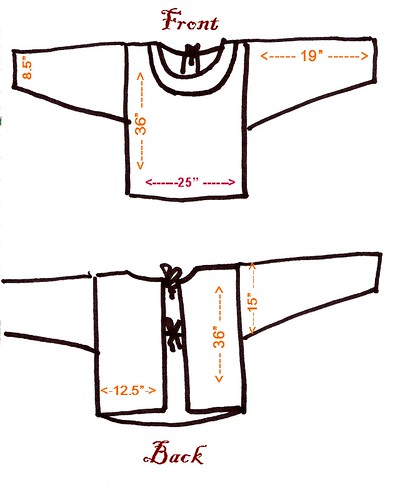
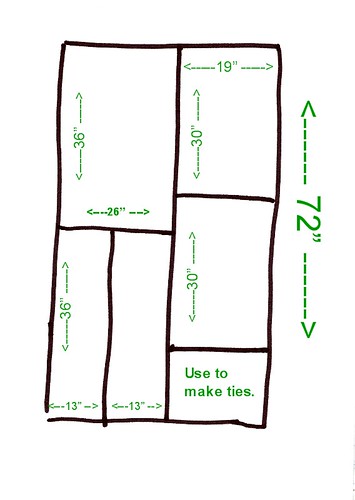

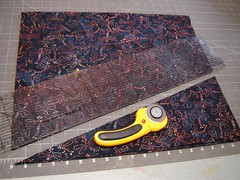
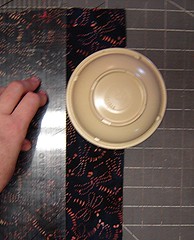
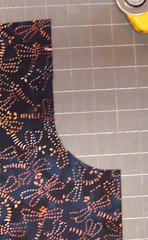
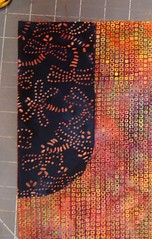
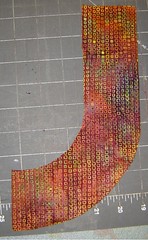

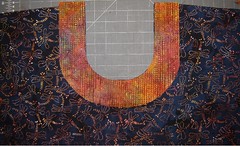
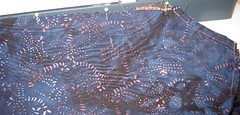

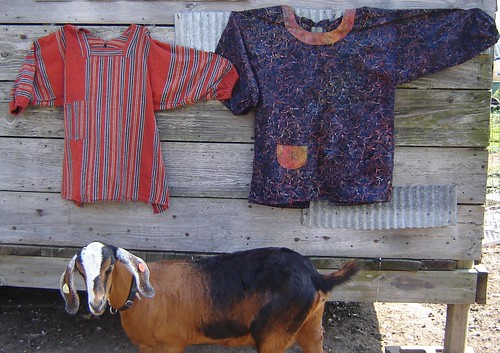

14 comments:
You are not letting the goat eat that apron are you? I am excited about this tutorial.
what a great tutorial! One could forgo the split back(make it a solid piece) and wear this as a shirt!
I love the goat pics...too cute!
The thought of turning that into a shirt crossed my mind. It makes a great peasant blouse.
This looks great. My daughter brought back an original apron from Japan. looks like this one but much longer and hot looking. lol it is all black.
Omayra
Hi Lucy,
What a great tutorial. I always enjoy stopping by you site.
Wanted to let you know I'm having a contest over at my site if you're interested. Anyone can enter.
jessica
Thanks for the tutorial... I was looking to buy one for a painting smock... but I may have to break down and make one.
Thanks Lucy, it now makes sence to me :o) If I can find ribbing that matches I may put that at the cuffs because my fabric was only 42 inches wide because of the blank space at the salvege edge.
I love Nubian's! She's very pretty! They are really sweet and love to be part of the family.
Great site. There is a site www.eastwindart.com that has a kappogi apron. The sleeves are full and usually has elastic by the wrist. This is so if a Japanese lady happens to be cooking in a kimono, her sleeve will be out of the way and not get dirty. Patti
I was wondering what size are you for the dimensions you have given for the pattern. I want to make one for my mother who is about 5' and weighs about 160 pounds (round around the middle). Will this pattern be too long and too small?
Well I am not small by any means. I am a generous 18 and am 5'7". I would guess that this apron would be long for her but if you read the instructions I posted at the first of the tutorial you will see what the general measurements of the apron are and can adjust them to fit anyone. I would add 10 inches to a middle measurement for ease. For legnth just measure from the shoulder down as far as you want and allow 2 inches for ease and seam allowances. Same on the sleeves. Hope that helps.
Thanks for favoriting our Etsy shop. That brought us to your charming blog. I love this Japanese tutorial. Looking forward to more.
Love it...what type of fabric would be both protective yet comfortable?
Tightly woven fabrics work well. This was made with batiks and it keeps me clean but if you are doing something really wet,like dishes, you will get wet.
Post a Comment